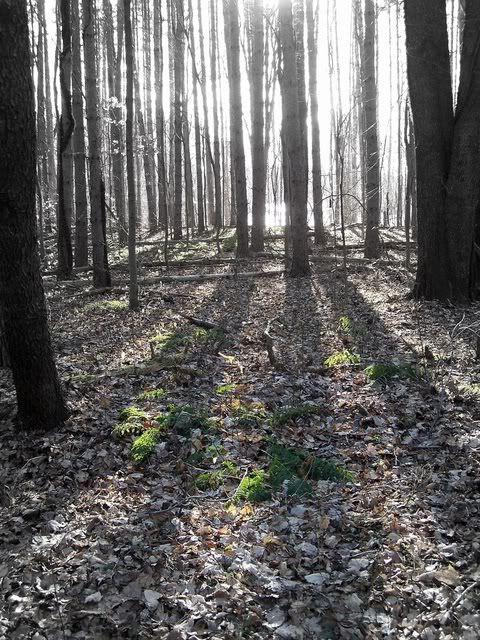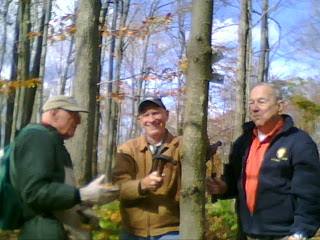The following are excerpts from the trail journal of Tilly Ernisse, and are used here with her permission. It was hard to select just a few passages. Follow the link at the end to read her entire story. I’ll begin with part of her conclusion...
Conventional wisdom holds that hiking is a mental game. I think that real life is a mental game. When you're hiking you're guaranteed to be tired, hungry, sore, painful, wet, cold, or hot at all times. But mentally you are free. You make the decisions. You are beholden to no one. You deal with nothing that you don't want to deal with, even though you are protected from nothing. In regular life all your physical aspects are taken care of but mentally you're screwed--bills, coworkers you don't like, traffic, errands you don't want to do, obligations you don't want to have. But your hair will be washed, you'll sleep in a soft bed, and the temp will always be 68 degrees.
So I don't know. I wish that I could live my life in reverse--instead of 1 dayhike in the woods 1x a week and 6 days in town, I could hike 6 days a week and stop in town only once.
I am hiking a section mostly contained within the Manistee Nat'l Forest, MI, and really, I do realize that 115 miles or so out of 4,200 is like a 2% section. But a section it is!
9/30/2008
Nichols Lake Boat Launch
The drive up started out okay. I replaced my expired license plates with newly acquired, legal and up-to-date ones, we stopped at Subway for sandwiches to eat later at camp, and we made good time, despite intermittent rain from black clouds and some traffic in Grand Rapids. When we got into Manistee NF, the road got narrow and windier, and I noticed more conifers in the woods.
"I like the north woods," said Matt.
We turned onto the road leading to the campground, and seconds later I slowed in front of a yellow gate shut across the road that said "Road Closed."
There were some lemon-yellow sassafras trees, and some trees with peach colored leaves, too. This should have made me excited and happy, but instead I just felt kind of anxious...
...We went for a quick walk in the dark after we ate dinner. I was having this fantasy on the way back to the tent that it would be all slashed to pieces, and then me and Matt would dash to the car but it wouldn't start because the mastermind killer already cut some important cables.
I guess I've seen too many 80's horror movies.
Well this trip isn't starting out on the right foot, but we'll see what tomorrow brings.
Wednesday, Oct 1/08
Baxter Bridge & No 29 1/2 Road to Wheeler Creek
Well, I've lived to tell the tale of today. Last night was very dark, with no moon, and heavy intermittent rain...
...I like this trail so far. Highbanks Rollway has a lovely view of the Manistee River that you could see from a very involved viewing deck that must have been a lot of work to build. The trail wandered along the bluffs and valleys along the river. I was surprised at how steep and long some of the bluffs actually were.
So that was nice. Wonderful campsites scattered high above the river in this section,
Thursday, October 2/08
Wheeler Creek to Eddington Creek
Slept okay despite lumpy, awkward ground. Woke up, ate, and had great coffee. Rain hit and did not stop for 3 hours. We crossed 37 after a mile in and started a 5 mile roadwalk. Just as we started a little black husky mix began following us. He was a great trail dog-stayed with us, happy and loving. We thought he would go home eventually but... called animal control and they gathered our dog. Best for him and for us though it was sad...
...Salmon and couscous is good.
Goodnight little dog, I hope you're dry and your belly is full.
Friday, Oct 3/08
Eddington Creek to Hemlock Stand Above Leitch Bayou
Finally! A semi-sunny morning that changed everything. Lovely dappled forest high up on the bluff, and below in the ravine the sunlight was burning up the mist. I accidentally scared a raccoon that was starting to climb a tree. He froze, then ambled away from the trail into the woods. Kind of like now, it's 8 pm, dark, and something is moving around outside our tent, but I don't know what it is and it's freaking me out a little. It's probably just a porkie/raccoon.
Anyway, the trail was high and dry today, ascending and descending through huge ravines on 100% footpath, not even any woods roads...
...We found camp in a lovely stand of huge, healthy, and mature hemlocks like I've never seen. They are about 3' in diameter, tower high, and are full of needles. I can't believe how well this worked out. I love hemlocks. This is a great campsite, and a good end to a hard day.
Saturday, Oct 4/08
Hemlock Stand Above Leitch Bayou to 2 Mi. S. of 9 Mile Bridge
Lots of owls and nighttime animals in our camp, but we woke unscathed...
...We hiked a few hours through sunny skies to Udell Trailhead, which had a water pump and a picnic table, so we tanked up with water and had a yummy hot ramen lunch.
The 6 miles after that were dreamy. The woods were beautiful, open and mature, still green, and completely open underneath. The soil changed to a sandy base, and then pines dominated with a grassy understory. Lovely woods, some sun, a perfect walk. Possibly the best section so far, excepting the parts above the river. I was tired and hurting all over, but this section mentally made me very happy
Sunday, Oct 5/08
2 Mi. S. of 9 Mile Bridge to McCarthy Lake
...After an atrocious-PAVED-roadwalk that made my feet feel split in 1/2, [
sorry Tilly, we can’t find any way to make it go away] we found a small grocery/liquor store (more liquor than grocery) that was run by a very nice woman. We were able to get cheese & crackers, snickers, and ramen, which will do for 1 1/2 days. She also, thank God, had Carmex (my lips are a bloody, cracked, chapped mess and look diseased, and it's starting to hurt to move my mouth in order to talk) and AA batteries for my camera.
I loved that little store. It was really cute country store, non-commercial, and sold some used clothing and books, too. In my dreams I could work at a laid back place like that...
Monday, October 6/08
McCarthy Lake to Bowman Bridge Nat'l Forest Campground
Rain and darkness for most of the day. .. The low point hit me at lunch at Pere Marquette River access bridge. I was damp, and a cold wind came through and chilled me further. I watched people who were fly fishing and thought, hey, that's a good hobby. Get out for awhile, enjoy yourself, then go home to warmth, a comfortable couch, and possibly some hot chocolate. After that thought, I ate my pepper-jack and triscuits, and we got back on the trail. I started feeling 100% better, mentally and physically. I guess 4 hours between small snacks is too long.
Tuesday, October 7/08
Bowman Bridge NF CG to Highbank Lk NF CG
We walked the first 5 miles in a steady clip and finished them in 2 hours. The next section of the day was weird for me. I drank too much coffee this morning, and I was feeling lightheaded and not all there (probably from the caffeine crash.) The trail lead us near private property where the path was fenced in on both sides, then along a 3 mile marshy area that had barbed wire, red flagging tape, and No Tresspassing, Private Property, Will Prosecute signs posted every 6 feet. That, along with faint trail (but thankfully excellent blazing) made me want to get out of that section, fast.
Wednesday, Oct 8/08
Highbank Lk NF CG to Nichols Lake
The last 2 miles we slowed the pace and walked through a nice pine stand. Finally Nichols Lake came into view on my left. It is the largest lake we've walked past on this trip, and it is the most beautiful. I was happy to end here. The grey sky reflected flat into the water. The grasses were still, and the area seemed calm, peaceful, and for lack of better words isolated (in a clean, wildernessy way, not in a bad way.) I forgot about being soaked from the inside out and just stared out over the water.
I made Matt check out my car. Still there. All intact. No ticket. Wow. I'll just say that I can't believe how well everything has fallen into place on this trip.
See
Tilly Ernisse's Trail Journal at trailjournals.com






























































